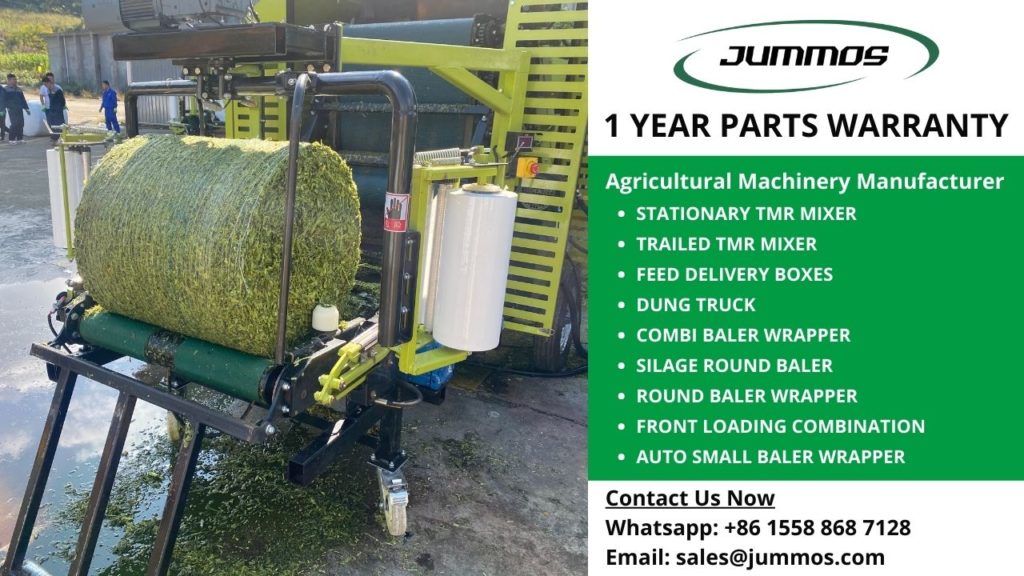There are several reasons why many farmers prefer a round bale wrapper over other forms. Balancing straw bales in large round bales requires less labor for bales and their transfer than in small square bales. When less labor is involved, then it is more profitable. Check the round bale wrapper for 850kg bales, it is suitable for for your farm.
Round bales are also easy to store. You can store the round bales wrapped in plastic outside as they are easier to distribute. While square bales are a bit difficult to store outdoors. The round bale wrapper uses LLDPE plastic films to wrap the bale. After the forage plants are cut quickly, then they will be immediately rolled up and wrapped in plastic to ferment as silage.
Contents
Advantages of Using Round Bale Wrapper
Winter is a threat to most ruminants. Many grasses or forages lose their nutrition due to freezing during this season. While farm animals such as cows or horses still need to consume fresh forage of about 2 percent of their body weight daily, the question arises: where are you going to find the feed? If only you had silage wrapped by a round bale wrapper, this problem would never exist.
Set the Ideal Humidity
The ideal humidity that can be maintained by the round bale wrapper for its silage is in the range of 45 to 55 percent with a good silage film. This creates the most favorable conditions for fermentation, which preserves the forage’s nutritional content.
Proper humidity ensures that livestock will not suffer from digestive problems due to high levels of butyric acid and ammonia. Silage or baleage with humidity levels exceeding 60 percent may appear wet, slimy, and produce an unpleasant odor, which can lead to decreased feed quality and health issues in ruminants.
Regulate Oxygen Levels in the Feed
Low humidity levels, often below 40 percent, can lead to signs of mold in bales. Mold indicates that oxygen has infiltrated the bale, which facilitates the growth of bacteria and fungi. This poses a significant risk as it can lead to listeriosis, a disease caused by the bacterium Listeria monocytogenes, commonly affecting sheep consuming forage exposed to open air after continuous rain.
By using a round bale wrapper, multiple protective layers prevent oxygen from entering and safeguard the forage from harmful bacteria and fungi. For instance, wrapping with four layers of 1.5 ml film or six layers of 1.0 ml film ensures an airtight environment that preserves the quality of the forage.
Easy to Move to Various Locations
Silage wrapped using a round bale wrapper is easy to transport to different locations because it only needs to be rolled. This is especially useful for large farms or those that need to transport feed across varied terrains. Moreover, these bales remain ready for consumption, whether incorporated into a Total Mixed Ration (TMR) or fed directly.
Providing individual containers for horses can help maintain hygiene and prevent contamination from other animals’ waste. This ensures each animal receives clean forage without unnecessary mixing.
Stack Round Bales
Limited storage space can be a challenge for farmers. Fortunately, round bales can be stacked using the correct method. The pyramid stack arrangement is recommended for optimal space usage.
However, it is crucial to keep in mind that stacks of round bales should not be used as a play area for children, as excessive movement can lead to shrinkage or damage. If more storage space is available, stacking may not be necessary, allowing bales to maintain their structure and quality.
Wilted Bales
When stacking round bales, it is important to assess the condition of each bale. Wilted bales should be stored on the ground, positioned with a slight bend or flat edge to maintain stability. The maximum stacking height for wilted bales should not exceed three layers to prevent compaction and maintain quality.
Bales That Do Not Wilt
For bales that are not wilted, stacking on top of the second or third pile is permissible, provided that the base is curved. The maximum stacking height for unwilted bales should be two layers. Proper stacking techniques help preserve the integrity of the bales and prevent spoilage.
Additional Considerations
Using a round bale wrapper comes with minor challenges, such as the need for proper wrapping techniques and monitoring of weather conditions during wrapping. Farmers should pay close attention to the forage’s condition before wrapping, the surrounding weather, and the animals’ feeding behavior to ensure the best results.
Round bale wrappers remain the preferred choice for farmers due to their efficiency, protection against spoilage, and ease of handling, making them an essential tool for modern livestock management.

